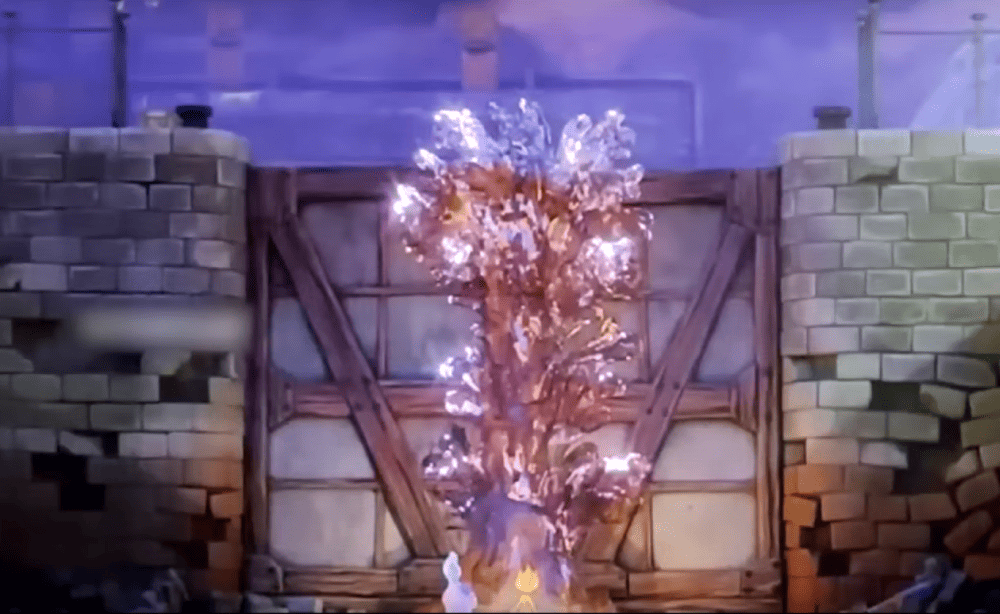
[Image above] In this screenshot from the movie Elemental, the fire character Ember and the water character Wade admire the tempered glass that Ember created to patch a hole in the canal wall. Credit: Edit Man, YouTube
*This post contains spoilers for the movie Elemental
When I saw the new Pixar movie Elemental over the July 4 weekend, I was expecting a romantic comedy that, per reports, wasted the potential of characters based on the Greek classical elements (fire, air, water, earth). Though it’s true the air and earth characters received little screen time, I was thrilled to discover the main fire character, Ember, had a unique skill—glassblowing!
In general, glass is created by heating sand to very high temperatures and then shaping the molten material into a desired shape. In the movie, Ember uses her flames to melt sand and broken glass so it can be turned into new products, including a bakery display case, a vase, and a sphere-enclosed glass flower.
During one key part of the movie, Ember discovers there are not enough sandbags to stop water coming through a hole in the canal’s side weir (area for diverting overflow water from the main channel). So, she torches the bags and uses the molten sand to create a glass patch over the hole.
A city inspector is initially skeptical of Ember’s solution. But after confirming it is tempered rather than regular glass, the inspector approves the fix—which proves to be a mistake when the glass shatters later in the movie.
Though using glass to prevent flooding may sound unprecedented, glass flood walls do exist. However, these walls rely on laminated glass panels, or panels that have one or more thin polymer interlayers between each glass layer.
Could a single piece of tempered glass be used to hold back flood water?
Let’s first address the fact that Ember was able to create tempered glass at all. Based on context clues, Element City is a coastal city, so the sandbags that Ember melted would likely be filled with beach sand. Most beach sand is made up of quartz, or silicon dioxide (silica). The coefficient of thermal expansion for silica is exceptionally low, so it is not possible to thermally temper pure silica.
Additional materials, such as boron trioxide, sodium oxide (soda), or calcium oxide (lime), must be added to the beach sand if it is to be successfully tempered. Ember was fortunate that the sandbags contained the right composition to undergo thermal tempering.
Putting aside the question of glass composition—and the additional factor of debris in the canal—tempered glass should be able to withstand the water pressure. Concrete, the main material used to construct canal walls, is expected to have a minimum compressive strength of 5,000 psi (34.5 MPa). Depending on thickness, tempered glass can have a compressive strength from tens of MPa to a few hundred MPa, easily matching this minimum requirement.
The most likely point of failure would be the interface between the glass patch and reinforced concrete wall. As discussed in the May 2021 Bulletin, bonding dissimilar materials is difficult because of the mismatch between properties, particularly the thermal expansion coefficient. This mismatch makes the interface susceptible to failure.
However, in the movie, the tempered glass cracked in the middle of the patch, where it was not touching the surrounding concrete. Why? In an email, ACerS Fellow and The Pennsylvania State University professor John C. Mauro suggests a possible cause.
Tempered glass gains its strength from the balance between compression on the outer part of the glass and tensile stress in the interior. This strength depends heavily on the thickness of the glass.
“Greater thickness is generally better, except if it became too thick the tensile stresses could exceed the fracture limit in the interior of the glass, causing it to break,” Mauro explains.

Ember’s tempered glass is clearly thicker in parts than the maximum 3/4” thickness of standard tempered glass. It is not unreasonable to assume, then, that the failure was caused by the tensile stresses exceeding the fracture limit.
By the end of the movie, Ember goes to intern with a glass manufacturing company. Hopefully there she will learn about the thickness requirements for tempered glass and so avoid this material failure in the future!
For students who would like to learn more about glass science, the Ceramic and Glass Industry Foundation’s newest program GLOW (Glass Learning Opportunities Workshop) offers the chance to combine hands-on glassblowing experience with a lecture on the underlying science. Materials for hosting your own GLOW event can be freely downloaded from the CGIF website.
